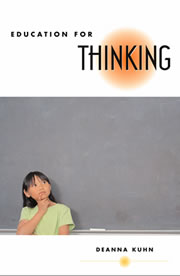Why Singapore’s English Teachers Should Embrace Singlish, Not Fight It
Is it time for Singaporean educators to embrace Singlish as a legitimate learning tool? What the Research […]
Read More
By Deanna Kuhn (2005), Harvard University Press, ISBN: 0-674-01906-7, 209 pp.
 A lot has been said about teaching thinking skills. In fact, terms like “innovation” and “independent learning” have been used so often, it has become almost cliché to mention them at all.
A lot has been said about teaching thinking skills. In fact, terms like “innovation” and “independent learning” have been used so often, it has become almost cliché to mention them at all.
Therefore, I was pleasantly surprised to find that Deanna Kuhn’s Education for Thinking, although not entirely new, was still quite different. Similar to other books on critical thinking, Kuhn calls for less emphasis on content and more effort in teaching students to use their minds. She sets herself apart by focusing on two specific thinking skills: inquiry and argument.
By focusing on depth rather than scope, Kuhn is allows her readers to understand these two types of thinking without feeling overloaded with information. It is obvious that she is well aware of the difficulties in teaching students to use their minds well.
As she states in her book, “Even the most conscientious and informed teachers are left with little to go on. A vast, seemingly uncharted terrain remains between executing the activity and developing the skills” (p. 41).
Therefore, Kuhn takes time to define the skills associated with inquiry and argument, to describe how it is taught and how it can be further developed. I considered this a nice change from being given a whole conceptual framework to master and put into practice. Teachers who prefer a more clear-cut discussion on teaching thinking in the classroom will appreciate this as well.
To help readers see how such thinking skills can be both present and absent in real situations, Kuhn draws from interviews and classroom observations conducted in two very different middle schools in the US – one serving a “disadvantaged community” and another that is serving a “highly advantaged” one.
I especially liked how Kuhn shows that while the two schools are undeniably different, there is a common lack of awareness as to what the value of school is. For students at the “struggling school”, it is something to “get over with” in order to secure jobs in the future. For students in the “best-practice school”, it is a vehicle to qualify for even more schooling such as colleges and universities. Beyond these goals, both groups fail to see other reasons why they’re learning what they’re learning.
Kuhn also includes research by other academics as well. Although some of these studies may be a bit harder to understand, the book is generally well organised, and she deliberately takes time to explain the purpose of each chapter to readers.
All in all, Kuhn’s book may be considered a bit of “heavy reading” for teachers in search of a more step-by-step reference on teaching thinking in the classroom. Still, I personally feel that Kuhn nicely straddles academic research and the realities of teaching. Given the many thinking approaches and strategies encountered by teachers today, anyone who ever thought, “How do we actually know all of this?” will find Kuhn’s book a refreshing change from the usual abstract notions of what teaching thinking really is about. One finishes the book feeling reflective about how we ourselves define what the purpose of school really is.